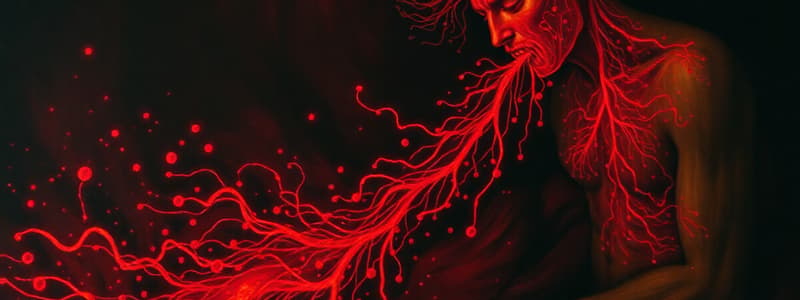Podcast
Questions and Answers
What is the primary cause of transient vasoconstriction in small arterioles during inflammation?
What is the primary cause of transient vasoconstriction in small arterioles during inflammation?
What effect does histamine primarily have on the capillaries during an inflammatory response?
What effect does histamine primarily have on the capillaries during an inflammatory response?
Which of the following is a consequence of vasodilation in arterioles during inflammation?
Which of the following is a consequence of vasodilation in arterioles during inflammation?
What primarily causes stasis in blood flow during the inflammatory process?
What primarily causes stasis in blood flow during the inflammatory process?
Signup and view all the answers
What characterizes the inflammatory fluid exudate?
What characterizes the inflammatory fluid exudate?
Signup and view all the answers
Which of the following is NOT a function of the inflammatory fluid exudate?
Which of the following is NOT a function of the inflammatory fluid exudate?
Signup and view all the answers
What is the significance of high fibrinogen content in inflammatory fluid exudate?
What is the significance of high fibrinogen content in inflammatory fluid exudate?
Signup and view all the answers
What leads to the formation of inflammatory exudates during inflammation?
What leads to the formation of inflammatory exudates during inflammation?
Signup and view all the answers
What occurs to lymphatic vessels at the end of inflammation?
What occurs to lymphatic vessels at the end of inflammation?
Signup and view all the answers
What is the main purpose of the local vascular reactions during inflammation?
What is the main purpose of the local vascular reactions during inflammation?
Signup and view all the answers
What suffix is commonly used to denote inflammation of an organ?
What suffix is commonly used to denote inflammation of an organ?
Signup and view all the answers
Which of the following is NOT a known cause of inflammation?
Which of the following is NOT a known cause of inflammation?
Signup and view all the answers
What characterizes chronic inflammation compared to acute inflammation?
What characterizes chronic inflammation compared to acute inflammation?
Signup and view all the answers
Which of the following examples depicts an organ with inflammation?
Which of the following examples depicts an organ with inflammation?
Signup and view all the answers
What is the primary purpose of inflammation?
What is the primary purpose of inflammation?
Signup and view all the answers
Which type of irritant is categorized as 'non-living'?
Which type of irritant is categorized as 'non-living'?
Signup and view all the answers
Acute inflammation is characterized by which of the following?
Acute inflammation is characterized by which of the following?
Signup and view all the answers
What occurs locally during acute inflammation?
What occurs locally during acute inflammation?
Signup and view all the answers
Which condition is specifically related to inflammation of the joints?
Which condition is specifically related to inflammation of the joints?
Signup and view all the answers
What is a character of inflammatory fluid exudate?
What is a character of inflammatory fluid exudate?
Signup and view all the answers
Study Notes
Inflammation-1
- Inflammation is a protective response of living tissue to an irritant.
- It aims to defend against harmful agents, remove damaged tissue, and initiate repair processes.
- Inflammation involves local tissue, vascular, and lymphatic reactions.
Intended Learning Objectives
- Understand the definitions, types, causes, and nomenclature of inflammation.
- Describe the pathogenesis of acute inflammation.
- Characterize and understand the function of inflammatory fluid exudate.
Definition of Inflammation
- Inflammation is a local tissue, vascular, and lymphatic reaction of living tissue against an irritant.
Nomenclature of Inflammation
- Inflammation is named by adding the suffix "-itis" to the affected organ's name (e.g., appendicitis for the appendix).
Causes of Inflammation
- Living irritants: Bacteria, toxins, viruses, parasites, fungi
-
Non-living irritants:
- Physical: Extreme heat, cold, radiation
- Chemical: Acids, alkalis, poisons
- Mechanical: Trauma, friction, foreign bodies
- Immunological: Allergic reactions
Types of Inflammation
- Acute Inflammation: Sudden onset, short duration (days to weeks).
- Chronic Inflammation: Gradual onset, long duration (months to years).
Pathogenesis of Acute Inflammation
- Local tissue reactions: Occur at the site of inflammation, characterized by maximum irritant concentration and tissue death (necrosis). Cells release chemical mediators like histamine, serotonin, and prostaglandins.
-
Local vascular reactions: Inflammation involves a sequence of events involving blood vessels:
- Transient vasoconstriction: Immediate, brief narrowing of arterioles.
- Vasodilation: Widening of arterioles, venules, and capillaries due to histamine action; leading to redness and heat (hyperemia).
- Slowing of blood flow (stasis): Increased blood viscosity due to inflammatory exudates; slowing of blood flow. Histamine causes vascular endothelium swelling & stickiness to slow blood flow further.
- Formation of inflammatory exudates: Plasma and cells leak into interstitial spaces forming exudates. It consists of inflammatory fluid and inflammatory cells (leucocytes).
- Lymphatic vessel dilation: Drains fluid exudates at the end of inflammation.
Inflammatory Fluid Exudate
- High protein content: 4-8 gm% versus 1 gm% for normal interstitial fluid.
- High fibrinogen content: Causes turbidity and clotting when standing.
- High specific gravity: Above 1018
- High cellular content: Polymorphs and macrophages.
Functions of Inflammatory Fluid Exudate
- Minimize effects of toxins: Dilutes chemicals, poisons, toxins
- Carry antibodies: Transport antibodies to the inflamed site
- Supply nutrients and remove waste: Provides cells with vital elements and removes waste.
- Form a barrier: Fibrin network prevents infection spread and helps cells reach the irritant.
Studying That Suits You
Use AI to generate personalized quizzes and flashcards to suit your learning preferences.
Related Documents
Description
This quiz covers the fundamental aspects of inflammation, including its definitions, types, causes, and nomenclature. Learn about the protective role of inflammation, the pathogenesis of acute inflammation, and the significance of inflammatory fluid exudate. Test your understanding of this essential biological response.




